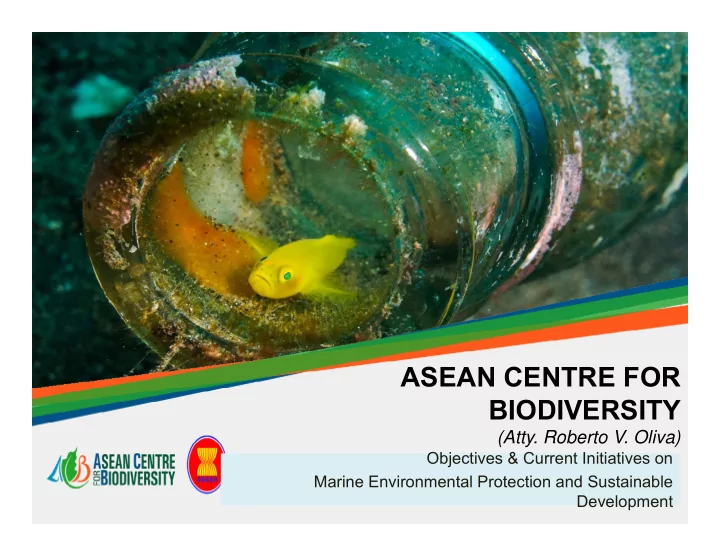

ASEAN CENTRE FOR BIODIVERSITY (Atty. Roberto V. Oliva) Objectives & Current Initiatives on Marine Environmental Protection and Sustainable Development
ASEAN: A region with immense biodiversity wealth
I. ASEAN: A region with immense biodiversity wealth
SOUTH EAST ASIA : 3% of the world’s total surface RICH IN BIODIVERSITY ! 3 ASEAN countries are ‘Mega-Biodiversity’ countries
3% of the world’s total surface, but • 20% of all known global species of flora and fauna live in its mountains, jungles, rivers, lakes and seas • 30% of global coral reefs • 35% of the global mangrove forests • Over 200 Million hectares of forest cover
2015: ASEAN Economic Integration As of 2014, 7 th largest economy in the world with • combined GDP of USD 2.4 Trillion. 4 th in the world by 2050 • • Over 620 million people • ASEAN potential market is larger than European Union or North America
ASEAN Biodiversity is under threat!
ACB Establishment • 2005 • 2005 ‐ 2010 (ASEAN ‐ EU Cooperation
ACB’s Mission To facilitate cooperation and coordination among the members of ASEAN: • Conservation • sustainable use of biological diversity • and the fair and equitable sharing of benefits arising from the use of such biodiversity in the ASEAN region
Operational Supervision Technical Oversight: G overning B oard composed of the ASEAN Senior Officials on the Environment (ASOEN) and the ASEAN Secretary General A SEAN W orking G roup on N ature C onservation and B iodiversity ; represented at the ASEAN WG on Coastal and Marine Environments
ACB Programme Areas Thematic Concerns • Access and benefit sharing • Biodiversity information management • Ecotourism, business and biodiversity • Climate change and biodiversity • Taxonomy and invasive alien species • Species conservation and wildlife law enforcement • Economics of ecosystems and biodiversity, and conservation financing • Public awareness
Geographical Concerns Geographical Concerns • ASEAN Heritage Parks and protected area management • Transboundary protected areas • Coastal and marine biodiversity • Wetlands and peatlands • Agro ‐ biodiversity • Urban biodiversity
Current Initiatives on Marine Environmental Protection and Sustainable Development
ASEAN Heritage Parks Programme • Flagship Programme of the ASEAN – ACB is the Secretariat of the AHP Programme • Predominantly terrestrial but increasing nomination of marine AHPs • 4 out of 37 AHPs are marine • ACB helps AHPs improve their management plans and also their management effectiveness • Complements 5-year SDS-SEA – Ensuring ES of marine habitats in the ASEAN Region – Promotes wise use of marine areas – Will contribute to best practices in ICM
What is an ASEAN Heritage Park? - a protected area of high conservation importance preserving in total a complete spectrum of representative ecosystems of the ASEAN Region
What is an ASEAN Heritage Park?
ASEAN Heritage Parks Country No. • 4 marine Brunei Darussalam 1 • 29 terrestrial Cambodia 2 • 4 wetlands Indonesia 4 Lao PDR 1 Malaysia 3 Myanmar 7 Philippines 8 Singapore 2 Thailand 4 Viet Nam 5 Total 37
Joint ACB – PEMSEA Initiative Achieving the AICHI Targets through the Integrated Coastal Management. Jointly proposed to: Scale up the coverage and effectiveness of marine conservation areas and threatened species protection in Southeast and East Asia Mainstream marine biodiversity conservation into the coastal and ocean management and sustainable development programmes at the regional, national and local levels in the Southeast and East Asia regions
EAAFP partnership ACB joined the East Asian AustralAsian Flyway Parnership in 2014 Conservation of migratory waterbirds and their intertidal habitats
Way Forward
Planned Programmes and Projects Increase Coastal and Marine AHPs In coordination with the Ramsar Convention Secretariat • In harmonizing efforts and resources for AHPs that are also Ramsar Sites (currently three sites) In coordination with the CTI ‐ CFF Secretariat • To upscale the implementation of the Regional Plan of Action (RPOA) • To promote synergy between CTI countries and other ASEAN Member States In coordination with USAID • To address illegal wildlife trade by strengthening wildlife law enforcement initiatives • In coordination with the Secretariat of the Convention on International Trade in Endangered Species of Wild Fauna and Flora
www.aseanbiodiversity.org
Recommend
More recommend